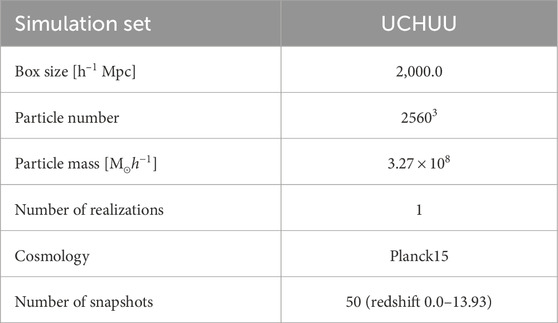- 1Department of Physics, The University of Tokyo, Bunkyo, Japan
- 2Kavli IPMU (WPI), The University of Tokyo Institutes for Advanced Study (UTIAS), The University of Tokyo, Kashiwa, Japan
Introduction: We aim to provide forecasts for future line intensity mapping (LIM) observations and galaxy redshift surveys, focusing on the physical properties of low-density region of the cosmic web (voids). We study how the measured physical properties depend on the observational methods for void detection and identification.
Methods: We generate mock intensity maps targeting the far-infrared CO(3–2) emission line by assigning the line luminosities to dark matter halos in cosmological simulations. The popular void-finding algorithm VIDE is applied to identify cosmic voids and quantify their properties. We analyze the voids detected in two different observation modes: (1) three-dimensional galaxy redshift surveys and (2) two-dimensional LIM observations corresponding to a single-frequency bin at 173 GHz.
Results: We find that the measured void size functions and radial density profiles differ depending on the observational method. These features exhibit characteristic signatures that reflect both the underlying cosmology and the nature of the emission-line galaxies.
Discussion: LIM-based void detection is a promising avenue for cosmological studies. We discuss the potential of combining LIM and galaxy survey data in a joint analysis to improve constraints on cosmological parameters and to better understand emission-line galaxy populations.
1 Introduction
The large-scale structure (LSS) of the universe has been playing a critical role in modern cosmology. Statistical analysis of this LSS allows precise measurement of the geometry and energy content of the universe. Conventionally, photometric or spectroscopic galaxy surveys have been conducted to generate large-scale cosmic maps (Guzzo et al., 2018). Direct measurement or inference of the redshifts of a large number of galaxies is a costly process, and several years of operation of a large telescope is typically needed to complete a deep and wide-area survey of millions of galaxies.
Line intensity mapping (LIM) is an emerging observational technique for probing the distribution of galaxies in two and three dimensions in an efficient manner. LIM can be used to measure the collective intensity at a specific frequency from all emission sources, including those that have been redshifted on the frequency band. This feature enables detection of faint sources that cannot be identified individually, making LIM a unique method for probing the distribution of entire galaxy populations (Bernal and Kovetz, 2022; Kovetz et al., 2017). The large-scale matter distribution probing capacity of LIM offers invaluable opportunities for a wide range of studies in cosmology and fundamental physics. For example, it is possible to detect baryon acoustic oscillations and determine the expansion history of the universe through LIM observations (Karkare and Bird, 2018; Bernal et al., 2019). Multitracer LIMs enable placing tight constraints on the mass of the cosmic relic neutrino (Shmueli et al., 2025). LIM also provides a novel probe for small-scale clustering of dark matter (Muñoz et al., 2020) and hence its particle nature (Bauer et al., 2021; Sarkar et al., 2022).
Wideband or multifrequency LIM can be used to study the evolution of galaxies and history of cosmic star formation (Béthermin et al., 2022) through detection of a combination of various emission lines from hydrogen, carbon, and oxygen. LIM experiments in the far-infrared to millimeter range have allowed us to detect a set of molecular lines. Some of the ongoing and planned LIM experiments include CONCERTO (Van Cuyck et al., 2023), EXCLAIM (Ade et al., 2020), TIM (Vieira et al., 2020), and SUBLIME-TIFUUN (Kohno et al., 2024). The brand-new satellite SPHEREx is soon expected to provide near-infrared intensity maps for a very large area of the sky with high spectral resolution (Doré et al., 2014). Hence, it is important and timely to explore how we can use data from future observations for an array of studies in cosmology and astrophysics. In this work, we study the statistics of LSSs probed by CO(3-2) LIMs and galaxy surveys using mock observational data generated from cosmological simulations. In particular, we focus on cosmic voids and examine how they can be located in different types of observations. We first describe our method of void detection and then introduce a few basic statistics; then, we show the statistics derived from our simulations, followed by a discussion and some concluding remarks.
2 Galaxy distribution and LIM
We expect that the line intensities or intensity fluctuations reflect the underlying matter density fluctuations as
where
There are already several successful observations of major line emissions from galaxies and the intergalactic medium. The HI intensity has been measured through cross-correlations between radio emissions and available galaxy redshift survey catalogs (Masui et al., 2013; Wolz et al., 2022). Other lines such as [CII] and CO emissions from high redshift have also been detected (Pullen et al., 2018; Yang et al., 2019). Low-density regions or cosmic voids can potentially be powerful probes for cosmology (Colberg et al., 2005). The abundant voids as functions of size (radius) and the density distribution within a void are believed to contain rich information on cosmology and the physics of galaxy formation. Galaxy surveys with sufficiently large effective volumes have been conducted only recently and have allowed measurements of the basic statistics of voids (Fernández-García et al., 2025). LIM is an efficient method for surveying a large volume and is also useful for considering multiple lines for detecting voids.
3 Methods
We used the Uchuu simulation (Ishiyama et al., 2021) to generate a three-dimensional galaxy distribution. The basic information regarding the Uchuu halo catalog used in this study is listed in Table 1. The halo catalogs were constructed using the ROCKSTAR halo finder and consistent-tree code (Behroozi et al., 2012a, 2012b) at redshift 1.0.
Since the Uchuu simulation utilizes only one cosmological model, we used the COLA code1 (Koda et al., 2016) to generate matter and halo distributions for different cosmologies. Herein, we briefly describe the mockups generated for this study.
We generated a 3D halo catalog with a lower mass cutoff at
We generated a three-dimensional DESI mock catalog of [OII] emitting galaxies for DESI observation using the halo catalog of the Uchuu simulation. Here, we used halotool to populate galaxies in the dark matter halos using the halo occupation distribution (HOD) approach.
We generated LIM mocks using the halo catalogs generated by COLA. Here, we assumed the same two cosmological models as noted above, with the box size being 300.0 h–1 Mpc, number of particles being 5123, and redshift being set to z = 1. We assigned the CO(3-2) line luminosity as a function of halo mass, whose details are further described in Section 3.2.
3.1 Mock DESI galaxies
We employ the HOD approach suitably calibrated to the [OII] emission-line galaxies (ELGs) observed by DESI (Rocher et al., 2024). We assume a Gaussian HOD model for the central galaxies with the expected occupation
and a power law model for the satellite galaxies with
Here, Ac and As set the number density to match those of the observed galaxies; Mc is the typical halo mass to host the [OII] emitter as a central galaxy;
where r is the distance from the halo center and rs is the scale radius. The HOD parameters used in the present study are listed in Table 2.

Table 2. Halo occupation distribution parameters used for DESI mock. The parameters were fitted against the clustering signal from the DESI 1 percent survey.
3.2 CONCERTO LIM mocks
We first generated 3D LIM mock catalogs using the COLA halo catalogs at redshift 1.0. It is expected that the star-forming galaxies at this redshift have strong CO(3-2) emissions as excellent targets for CONCERTO. We also included the interloper of CO(4-3) at redshift 1.67, which is redshifted to the same wavelength. Here, we briefly describe the method for assigning the CO(3-2) and CO(4-3) luminosities to each halo. First, we calculated the stellar mass of a halo using a double power-law stellar-to-halo mass ratio (SHMR) model proposed by Moster et al. (2010) as follows:
We then use the best-fit parameters derived in Girelli et al. (2020) (A = 0.0353, log(MA) = 12.05, β = 0.88, and γ = 0.599) with a 0.2 dex scatter. Next, we use an empirical relationship between the stellar mass and star formation rate (SFR) to calculate the infrared luminosity (Béthermin et al., 2022); in this procedure, we split the galaxies into star-forming and passive galaxies using the star-forming fraction given by Equation 1:
where
The SFR of a galaxy is calculated using Equation 2:
The infrared luminosity LIR is calculated from the SFR using the Kennicutt (1998) conversion factor of
The other transitions are calculated using the spectral line energy distribution template suggested by Bournaud et al. (2015). For the CO(4-3) interlopers, we generated a halo catalog at redshift 1.67 and calculated the CO(4-3) line luminosity using the steps described above. Since we expect that the CO(4-3) contaminants at z = 1.67 are not spatially correlated with the distribution of the CO(3-2) emitters at z = 1.0, we used a different random seed to generate the initial condition for the z = 1.67 halo catalog. We then downselect 20% of the halos by assuming that 80% of the interlopers can be removed using the methods discussed in Section 5. Although the contamination fraction is uncertain and arbitrary, we choose this value to quantify the impacts of the interlopers on void statistics.
We list the basic observational parameters used to generate the LIM catalog in Table 3; here, the parameters were set to closely follow the specifics of CONCERTO. We conducted the following analysis on a single slice of the LIM mock corresponding to an observer frame frequency of 173 GHz. Since we set the spectral resolution to 1 GHz and angular resolution to 32 arcsec, a single pixel in the 2D image included emissions from cubes of approximately 0.36 h–1 Mpc width and 19.5 h–1 Mpc depth for CO(3-2) emitters as well as 0.50 h–1 Mpc width and 18.1 h–1 Mpc depth for CO(4-3) emitters in the comoving space. We applied a minimum intensity threshold of 1 kJy/sr (corresponding to 0.52 K in brightness temperature) to remove low-intensity pixels with low signal-to-noise ratios in the actual observations and treated the pixels above this threshold as “signals” in the 2D maps.
3.3 Void detection
We located voids in the galaxy catalogs using a popular void finder called VIDE, whose full technical description is provided in Sutter et al. (2014); its applications in cosmology include cosmological parameter estimations using SDSS galaxies (Contarini et al., 2023) and constraints on neutrino masses (Bayer et al., 2024). Briefly, VIDE generates the Voronoi tessellation for a given particle (galaxy) distribution, where the density of each Voronoi cell is calculated as the inverse of its volume (or area in the 2D case). Cells that flow toward the same local density minimum are grouped together to form a zone; for each zone, the zone center is calculated as the volume-weighted center of all the particles in the zone, as shown in Equation 4:
The initial radius Rini of each zone is calculated as the radius of a sphere (or circle in the 2D case) using the corresponding volume (area) of the detected zone, as shown in Equation 5:
The central density of each zone is then calculated as the mean density within a spherical (circular) region around its center with a radius of 0.25Rini. For direct comparisons with theoretical or analytic models, the zones are cleaned and rescaled as described in Jennings et al. (2013). The procedures are as follows:
The void catalogs thus generated were used in the study subsequently.
4 Void statistics
4.1 Size function
One of the fundamental properties of a void is its size. Analogous to the halo mass function that characterizes the abundance of halos with different masses, the void size function describes the abundance of voids with different sizes and serves as a crucial statistical measure of the voids present in a large volume. A theoretical prediction of the void size function was provided by Sheth and van de Weygaert (2004) using the excursion-set approach (Press and Schechter, 1974), according to which the void size function in the linear regime is expressed by Equation 6:
where
Here,
Here,
where
To predict the size function in a non-linear regime, we assume a volume-conserving model in which the total volume occupied by the voids is conserved within a single void-size bin. Under this assumption, the void size function can be rewritten as in Equation 11:
where
with
For biased tracers, the density threshold will also be biased, as shown in Equation 13:
where
Since we set our threshold as
Since the formation and evolution of voids are governed by the nature of dark energy and dark matter, the abundance of voids with different sizes is sensitive to the cosmological parameters (Li et al., 2012; Verza et al., 2019). Herein, we explore the size function of a void using different tracers and their dependence on the cosmological differences.
4.1.1 Void size function in galaxy distribution
We first calculated the void size functions for the halo catalog and DESI mock galaxies; here, we applied a low-mass cutoff at
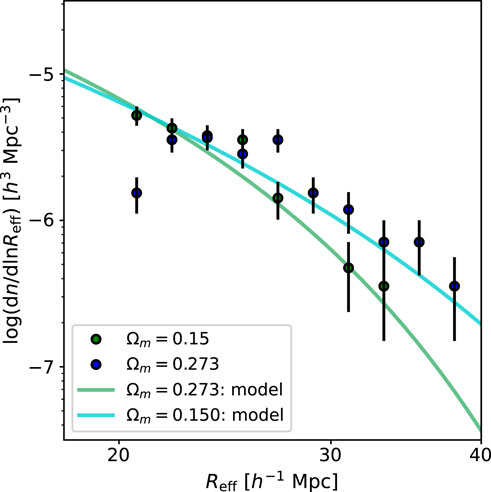
Figure 1. Size functions of voids detected from the halo catalog at different cosmology values: blue for Ωm = 0.273 and green for Ωm = 0.150. The plots show the size functions detected from the halo catalog, and the solid lines show the theoretical size functions calculated using the volume-conserving model of Equation 11. The error bars on the measured size functions are Poisson errors, assuming that the number of voids in each effective radius bin follows a Poisson distribution. We used decimal logarithmic void size bins ranging from 20 to 38 h–1 Mpc.
Figure 2 shows the void size function detected using the DESI ELG mock catalog. The linear bias of beff = 1.273 was chosen to match the predicted linear bias from the angular correlation function of the DESI ELG targets (Kitanidis et al., 2020). Although the theoretical prediction slightly underestimated the abundance of small voids, the model was generally in good agreement with the detected void abundances. Therefore, the volume-conserving void size function model could be directly compared to the void abundances detected from the DESI ELGs.
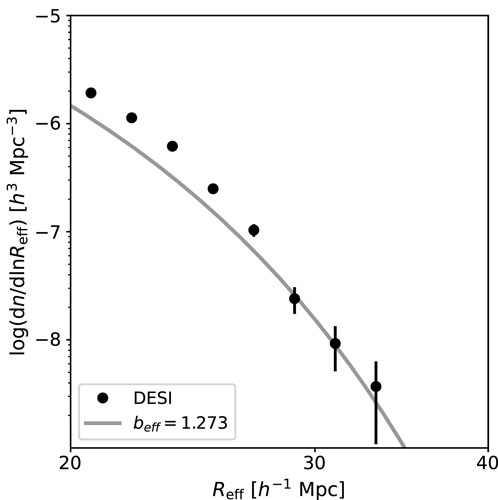
Figure 2. Size function of the voids detected from the DESI ELG mock catalog. The plot shows the size function detected from the halo catalog, and the solid line shows the theoretical prediction at redshift z = 1.0 with a linear bias of beff = 1.273. The error bars on the measured size function are Poisson errors, assuming that the number of voids in each effective radius bin follows a Poisson distribution. We used decimal logarithmic void size bins ranging from 20 to 38 h–1 Mpc.
4.1.2 Void size function in LIM
Next, we calculates the size functions of the voids detected in LIM. Figure 3 shows the void size functions for our LIM mocks under different Ωm. It is clear from the figure that the voids tend to be larger for smaller Ωm, consistent with the results of the 3D galaxy distribution in the previous section. We expect that the void abundance in LIM could also serve as a cosmological probe, although further detailed modeling will be necessary for it to merit precision cosmology.
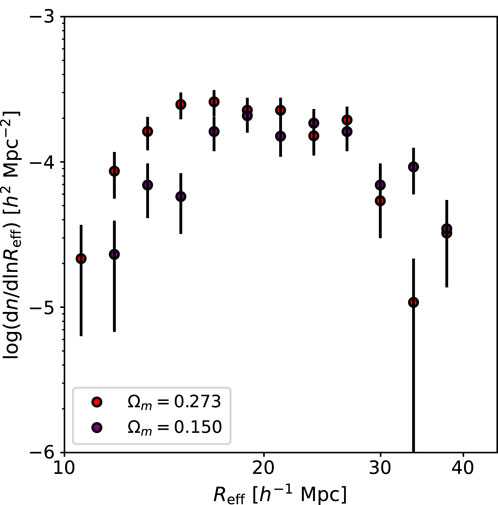
Figure 3. Size functions of voids detected from CO(3-2) LIM (without interlopers) at different cosmology values: red for Ωm = 0.273 and purple for Ωm = 0.150. The error bars on the measured size functions are Poisson errors, assuming that the number of voids in each effective radius bin follows a Poisson distribution. We used 12 logarithmic void size bins ranging from 10 to 40 h–1 Mpc.
We also investigated the effects of the main interlopers, namely, CO (4-3) emitters, on the detected void abundance. Figure 4 shows the void size functions with and without the CO(4-3) interlopers. The interlopers tend to generate more small voids and fewer large voids. In general, adding random points can have two competing effects; large voids are separated into smaller voids owing to random points located inside the large voids, whereas the increase in mean density causes shallow voids to merge into larger voids. For the interlopers considered in this study, we only included 20% of the halos at z = 1.67, which means that the signal from the interlopers is typically smaller than the CO(3-2) signal. In this case, the change in mean density is negligible, and the first effect or increase in small void abundance is dominant.
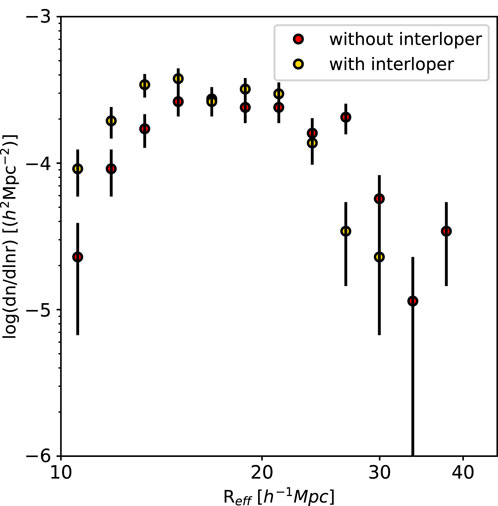
Figure 4. Size functions of voids detected from the LIM mock with (yellow) and without (red) the CO(4-3) interlopers. The error bars on the measured size functions are Poisson errors, assuming that the number of voids in each effective radius bin follows a Poisson distribution. We used 12 logarithmic void size bins ranging from 10 to 40 h–1 Mpc.
4.2 Radial density profile
The radial profile of the voids is another important characteristic of the cosmic structure, which may be sensitive to clustering scales smaller than the free-streaming lengths of dark matter and relic neutrinos. In our study, we defined the radial profile of the voids in terms of particle density as a function of distance from the void center; here, the void center was defined as the centroid of the void region.
4.2.1 Radial density profile in galaxy distribution
We first calculated the void size functions for the halo catalog and DESI mock galaxies. Figure 5 shows the radial density profiles detected from the halo catalog with different cosmology values. We observed that for a fixed void radius, the stacked density profile did not change for different Ωm. In general, the structures tended to become less clustered for lower Ωm, so we expect that the density profiles of the voids would become weaker for lower Ωm as well. However, since we are applying the same
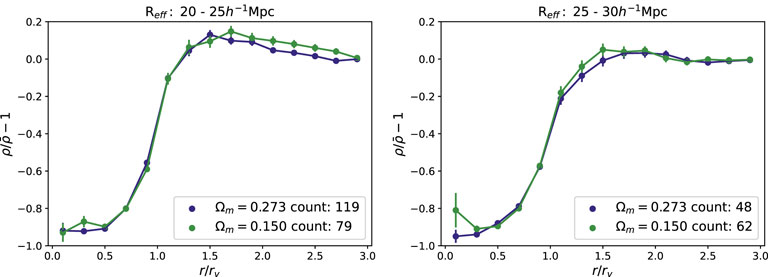
Figure 5. Stacked density profiles of voids detected from the halo catalog at different cosmology values: blue for Ωm = 0.273 and green for Ωm = 0.150. The y-axis represents the density normalized by the mean density, and the x-axis is the distance from the center normalized by the effective void radius. The two figures show the stacked density profiles of voids with different effective radii. In the left figure, we show the calculated density profiles of voids with effective radii of 20–25 h–1 Mpc. The plots show the mean density profiles of all voids considered, and the error bars are the standard errors
Figure 6 shows the radial density profiles detected from the DESI ELG mock catalog; comparing these with the void density profiles detected from the halo catalog, we note similar trends with void walls at around
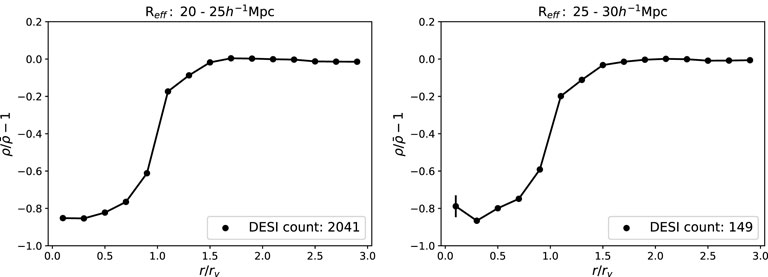
Figure 6. Stacked density profiles of voids detected from the DESI ELG mock catalog. The y-axis is the density-normalized by the mean density, and the x-axis is the distance from the center normalized by the effective void radius. The two figures show the stacked density profile of voids with different effective radii. In the left figure, we show the calculated density profile of voids with effective radii of 20–25 h–1 Mpc. The plots show the mean density profiles of all voids considered, and the error bars show the standard errors
4.2.2 Radial density profile in LIM
Next, we calculated the radial density profiles of voids detected in the LIM mocks. We defined the radial density profile as the number density of pixels above the assumed luminosity threshold. Figure 7 shows the stacked density profiles of the voids detected for different mocks. Similar to the case of the 3D voids, the radial density profile is insensitive to differences in Ωm. As with the trend for the 3D voids, we observed a steeper profile for the smaller voids. Compared to the voids detected in the 3D galaxy distribution, we argue that the LIM voids have higher density contrast and that the distances to the LIM void walls are less than the effective radius Reff. These differences can be explained by the high tracer biases expected on the LIM mocks. We removed all pixels with intensities below 1 kJy/sr (0.52 K), which resulted in extremely low densities in the inner parts of the voids. Because there were fewer particles in the inner regions of the voids, the effective radii extended to the outer parts of the void walls to exceed the density threshold of
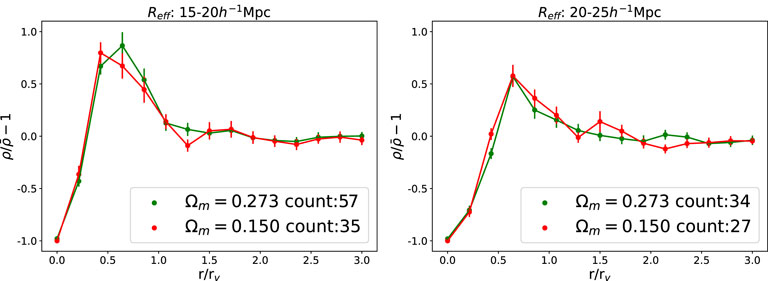
Figure 7. Stacked density profiles of voids detected from LIM at different cosmology values: green for Ωm = 0.273 and red for Ωm = 0.150. The y-axis is the density normalized by the mean density, and the x-axis is the distance from the center normalized by the effective void radius. The two figures show the stacked density profiles of voids with different effective radii. In the left figure, we show the calculated density profile of voids with effective radii of 15–20 h–1 Mpc. The plots show the mean density profiles of all voids considered, and the error bars show the standard errors
We also investigated how the interlopers affect the radial density profiles of the stacked voids. Figure 8 shows the radial density profiles of voids detected from LIM mocks with and without interlopers. The voids detected from the LIM mocks with interlopers tend to have shallower density profiles within
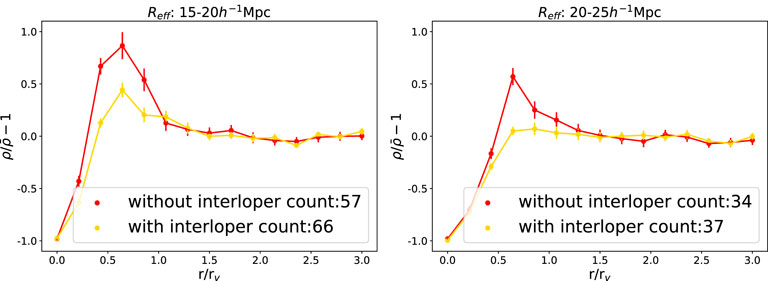
Figure 8. Stacked density profiles of voids detected from LIM mocks with (yellow) and without (red) the CO(4-3) interloper. The y-axis is the density normalized by the mean density, and the x-axis is the distance from the center normalized by the effective void radius. The two figures show the stacked density profiles of voids with different effective radii. In the left figure, we show the calculated density profiles of voids with effective radii of 15–20 h–1 Mpc. The plots show the mean density profiles of all voids considered, and the error bars show the standard errors
5 Discussion and conclusion
We studied the properties of voids that will be observed in future galaxy surveys and LIM experiments. Using the mock observational catalogs generated from realistic cosmological simulations, we explored the size function and radial density profile as useful tools for characterizing large-scale mass distribution. The main results of this study are summarized as follows:
Based on our results, we conclude that the volume-conserving model is a good starting point for conducting cosmological analyses using void size functions derived from galaxy redshift surveys. In our analysis, we detected voids in real space and did not include the redshift space distortion effect, which will need to be accounted for in actual cosmological analyses. The peculiar velocities of the galaxies around voids are expected to vary for different Ωm; thus, the radial density profiles in the redshift space may add additional information to the underlying matter distribution.
In this study, we confirmed the effects of interlopers and different cosmologies on the void properties. To conduct a cosmological forecast on future LIM observations, it is important to qualitatively evaluate the extents to which the void size functions and radial density profiles change under different cosmologies. These considerations along with more realistic observational effects, such as the foreground, are intended as our next step toward utilizing void properties to constrain cosmological models using LIM. Interestingly, state-of-the-art cosmological simulations have shown that galaxies residing in void regions, which are often referred to as void galaxies, have distinct properties over their counterparts residing in high-density regions (Rosas-Guevara et al., 2022). Therefore, the radial luminosity profiles of LIM voids could add information to the galaxy evolution model in the low-density regions. In this context, predictions using high-precision simulations for modeling radiation while accounting for environmental effects and mergers are required.
In the present study, we considered a simple interloper model in which 20% of the halos at z = 1.67 contaminate the intensity in the 173 GHz bin after the cleaning procedure. There are several approaches to mitigate interloper contamination. One such method is to perform component separation together with noise reduction and foreground removal, while another method may be to perform an end-to-end simulation so that the mock intensity catalogs also include multiple emission lines from galaxies at different redshift values. Several practical techniques have been proposed in this regard. Component separation is essential for detecting and characterizing voids, as we have explored herein; machine learning could be a powerful tool for this purpose (Moriwaki et al., 2020). Joint analysis of the galaxy surveys and LIM could also be a powerful tool for mitigating the effects of interlopers. Since the two sets of observations probe the same density fluctuations, the detected void distributions should have a positive correlation. Therefore, comparing the void properties from the two sets of observations is a powerful and robust analytical approach against interlopers.
The multiwavelength feature of upcoming LIM projects and its sensitivity to faint galaxies make LIM a powerful tool for understanding the evolution of galaxies and history of star formation. By investigating multiple emission lines, we expect to be able to probe multiple populations and gas phases of the galaxies. In this study, we did not assume any relationship between the line intensities and surrounding environments. However, by comparing the intensity profiles of void regions detected from observations and mocks including interactions between the LSSs, we expect to achieve a better understanding of how the surrounding environment affects the evolution of a galaxy. LIM experiments deliver massive amounts of data that include information on both the physical and frequency domains. Hence, it is important to consider the concerted use of theory, computations, data science, and artificial-intelligence-assisted studies (Moriwaki et al., 2023).
Data availability statement
The raw data supporting the conclusions of this article will be made available by the authors without undue reservation.
Author contributions
YY: conceptualization, investigation, methodology, and writing – original draft. NY: funding acquisition, methodology, supervision, writing – original draft, and writing – review and editing.
Funding
The author(s) declare that financial support was received for the research and/or publication of this article. The authors acknowledge financial support from the JSPS Kakenhi International Leading Research (no. 23K20035).
Acknowledgments
The authors thank Kana Moriwaki and Adrian Bayer for the insightful discussions. This research was supported by the Forefront Physics and Mathematics Program to Drive Transformation (FoPM), a WISE Program (Doctoral Program for World-Leading Innovative and Smart Education) at the University of Tokyo supported by MEXT, Japan. The authors also acknowledge the support of the Tokyo–Princeton Strategic Partnership for promoting academic exchange and collaboration.
Conflict of interest
The authors declare that the research was conducted in the absence of any commercial or financial relationships that could be construed as a potential conflict of interest.
Generative AI statement
The author(s) declare that no Generative AI was used in the creation of this manuscript.
Publisher’s note
All claims expressed in this article are solely those of the authors and do not necessarily represent those of their affiliated organizations, or those of the publisher, the editors and the reviewers. Any product that may be evaluated in this article, or claim that may be made by its manufacturer, is not guaranteed or endorsed by the publisher.
Footnotes
1COLA is a fast cosmological N-body simulation code using the COmoving Lagrangian Acceleration technique (Tassev et al., 2013).
References
Ade, P. A. R., Anderson, C. J., Barrentine, E. M., Bellis, N. G., Bolatto, A. D., Breysse, P. C., et al. (2020). The experiment for cryogenic large-aperture intensity mapping (EXCLAIM). J. Low Temp. Phys. 199, 1027–1037. doi:10.1007/s10909-019-02320-5
Bauer, J. B., Marsh, D. J. E., Hložek, R., Padmanabhan, H., and Laguë, A. (2021). Intensity mapping as a probe of axion dark matter. Mon. Not. R. Astron. Soc. 500, 3162–3177. doi:10.1093/mnras/staa3300
Bayer, A. E., Liu, J., Kreisch, C. D., and Pisani, A. (2024). Significance of void shape: neutrino mass from Voronoi void halos? Phys. Rev. D. 110, L061305. doi:10.1103/PhysRevD.110.L061305
Behroozi, P. S., Wechsler, R. H., and Wu, H.-Y. (2012a). The rockstar phase-space temporal halo finder and the velocity offsets of cluster cores. Astrophys. J. 762, 109. doi:10.1088/0004-637x/762/2/109
Behroozi, P. S., Wechsler, R. H., Wu, H.-Y., Busha, M. T., Klypin, A. A., and Primack, J. R. (2012b). Gravitationally consistent halo catalogs and merger trees for precision cosmology. Astrophys. J. 763, 18. doi:10.1088/0004-637x/763/1/18
Bernal, J. L., Breysse, P. C., and Kovetz, E. D. (2019). Cosmic expansion history from line-intensity mapping. Phys. Rev. Lett. 123, 251301. doi:10.1103/PhysRevLett.123.251301
Bernal, J. L., and Kovetz, E. D. (2022). Line-intensity mapping: theory review with a focus on star-formation lines. Astron. Astrophys. Rev. 30, 5. doi:10.1007/s00159-022-00143-0
Bernardeau, F. (1994). The nonlinear evolution of rare events. Astrophys. J. 427, 51. doi:10.1086/174121
Béthermin, M., Gkogkou, A., Van Cuyck, M., Lagache, G., Beelen, A., Aravena, M., et al. (2022). CONCERTO: high-fidelity simulation of millimeter line emissions of galaxies and [CII] intensity mapping. Astron. Astrophys. 667, A156. doi:10.1051/0004-6361/202243888
Bournaud, F., Daddi, E., Weiß, A., Renaud, F., Mastropietro, C., and Teyssier, R. (2015). Modeling CO emission from hydrodynamic simulations of nearby spirals, starbursting mergers, and high-redshift galaxies. Astron. Astrophys. 575, A56. doi:10.1051/0004-6361/201425078
Colberg, J. M., Sheth, R. K., Diaferio, A., Gao, L., and Yoshida, N. (2005). Voids in a ΛCDM universe. Mon. Not. R. Astron. Soc. 360, 216–226. doi:10.1111/j.1365-2966.2005.09064.x
Contarini, S., Pisani, A., Hamaus, N., Marulli, F., Moscardini, L., and Baldi, M. (2023). Cosmological constraints from the BOSS DR12 void size function. Astrophys. J. 953, 46. doi:10.3847/1538-4357/acde54
Contarini, S., Ronconi, T., Marulli, F., Moscardini, L., Veropalumbo, A., and Baldi, M. (2019). Cosmological exploitation of the size function of cosmic voids identified in the distribution of biased tracers. Mon. Not. R. Astron. Soc. 488, 3526–3540. doi:10.1093/mnras/stz1989
Doré, O., Bock, J., Ashby, M., Capak, P., Cooray, A., de Putter, R., et al. (2014). Cosmology with the SPHEREX all-sky spectral survey. arXiv. doi:10.48550/arXiv.1412.4872
Fernández-García, E., Betancort-Rijo, J. E., Prada, F., Ishiyama, T., Klypin, A., and Ereza, J. (2025). Constraining cosmological parameters using void statistics from the SDSS survey. Astron. Astrophys. 695, A19. doi:10.1051/0004-6361/202451264
Girelli, G., Pozzetti, L., Bolzonella, M., Giocoli, C., Marulli, F., and Baldi, M. (2020). The stellar-to-halo mass relation over the past 12 gyr: I. standard cdm model. Astron. Astrophys. 634, A135. doi:10.1051/0004-6361/201936329
Guzzo, L., Bel, J., Bianchi, D., Carbone, C., Granett, B. R., Hawken, A. J., et al. (2018). Measuring the Universe with galaxy redshift surveys. arXiv, 1–16. doi:10.1007/978-3-030-01629-6_1
Hamaus, N., Sutter, P. M., and Wandelt, B. D. (2014). Universal density profile for cosmic voids. Phys. Rev. Lett. 112, 251302. doi:10.1103/physrevlett.112.251302
Ishiyama, T., Prada, F., Klypin, A. A., Sinha, M., Metcalf, R. B., Jullo, E., et al. (2021). The Uchuu simulations: data Release 1 and dark matter halo concentrations. Mon. Not. R. Astron. Soc. 506, 4210–4231. doi:10.1093/mnras/stab1755
Jennings, E., Li, Y., and Hu, W. (2013). The abundance of voids and the excursion set formalism. Mon. Not. R. Astron. Soc. 434, 2167–2181. doi:10.1093/mnras/stt1169
Karkare, K. S., and Bird, S. (2018). Constraining the expansion history and early dark energy with line intensity mapping. Phys. Rev. D. 98, 043529. doi:10.1103/PhysRevD.98.043529
Kennicutt, R. C. (1998). The global Schmidt law in star-forming galaxies. Astrophys. J. 498, 541–552. doi:10.1086/305588
Kitanidis, E., White, M., Feng, Y., Schlegel, D., Guy, J., Dey, A., et al. (2020). Imaging systematics and clustering of desi main targets. Mon. Not. R. Astron. Soc. 496, 2262–2291. doi:10.1093/mnras/staa1621
Koda, J., Blake, C., Beutler, F., Kazin, E., and Marin, F. (2016). Fast and accurate mock catalogue generation for low-mass galaxies. Mon. Not. R. Astron. Soc. 459, 2118–2129. doi:10.1093/mnras/stw763
Kohno, K., Endo, A., Tamura, Y., Taniguchi, A., Takekoshi, T., Ikeda, S., et al. (2024). “Sub/millimeter-Wave dual-band line intensity mapping using the terahertz integral field units with universal nanotechnology (TIFUUN) for the atacama submillimeter telescope experiment (ASTE),” in Millimeter, submillimeter, and far-infrared detectors and instrumentation for astronomy XII. Editors J. Zmuidzinas, and J.-R. Gao (Bellingham, United States: International Society for Optics and Photonics SPIE), PC13102. doi:10.1117/12.3021109
Kovetz, E. D., Viero, M. P., Lidz, A., Newburgh, L., Rahman, M., Switzer, E., et al. (2017). Line-intensity mapping: 2017 status report. Report.
Li, B., Zhao, G.-B., and Koyama, K. (2012). Haloes and voids in f(r) gravity: haloes and voids in f(r) gravity. Mon. Not. R. Astron. Soc. 421, 3481–3487. doi:10.1111/j.1365-2966.2012.20573.x
Masui, K. W., Switzer, E. R., Banavar, N., Bandura, K., Blake, C., Calin, L. M., et al. (2013). Measurement of 21 cm brightness fluctuations at z ˜0.8 in cross-correlation. Astrophys. J. 763, L20. doi:10.1088/2041-8205/763/1/L20
Moriwaki, K., Filippova, N., Shirasaki, M., and Yoshida, N. (2020). Deep learning for intensity mapping observations: component extraction. arXiv 496, L54–L58. doi:10.1093/mnrasl/slaa088
Moriwaki, K., Nishimichi, T., and Yoshida, N. (2023). Machine learning for observational cosmology. Rep. Prog. Phys. 86, 076901. doi:10.1088/1361-6633/acd2ea
Moster, B. P., Somerville, R. S., Maulbetsch, C., van den Bosch, F. C., Macciò, A. V., Naab, T., et al. (2010). Constraints on the relationship between stellar mass and halo mass at low and high redshift. Astrophys. J. 710, 903–923. doi:10.1088/0004-637x/710/2/903
Muñoz, J. B., Dvorkin, C., and Cyr-Racine, F.-Y. (2020). Probing the small-scale matter power spectrum with large-scale 21-cm data. Phys. Rev. D. 101, 063526. doi:10.1103/PhysRevD.101.063526
Navarro, J. F., Frenk, C. S., and White, S. D. M. (1996). The structure of cold dark matter halos. Astrophys. J. 462, 563. doi:10.1086/177173
Navarro, J. F., Frenk, C. S., and White, S. D. M. (1997). A universal density profile from hierarchical clustering. Astrophys. J. 490, 493–508. doi:10.1086/304888
Press, W. H., and Schechter, P. (1974). Formation of galaxies and clusters of galaxies by self-similar gravitational condensation. Astrophys. J. 187, 425–438. doi:10.1086/152650
Pullen, A. R., Serra, P., Chang, T.-C., Doré, O., and Ho, S. (2018). Search for C II emission on cosmological scales at redshift Z ∼ 2.6. Mon. Not. R. Astron. Soc. 478, 1911–1924. doi:10.1093/mnras/sty1243
Rocher, A., Ruhlmann-Kleider, V., Burtin, E., Yuan, S., de Mattia, A., Ross, A. J., et al. (2024). The desi one-percent survey: exploring the halo occupation distribution of emission line galaxies with abacussummit simulations
Rosas-Guevara, Y., Tissera, P., Lagos, C. D. P., Paillas, E., and Padilla, N. (2022). Revealing the properties of void galaxies and their assembly using the EAGLE simulation. Mon. Not. R. Astron. Soc. 517, 712–731. doi:10.1093/mnras/stac2583
Sargent, M. T., Daddi, E., Béthermin, M., Aussel, H., Magdis, G., Hwang, H. S., et al. (2014). Regularity underlying complexity: a redshift-independent description of the continuous variation of galaxy-scale molecular gas properties in the mass-star formation rate plane. arXiv 793, 19. doi:10.1088/0004-637X/793/1/19
Sarkar, D., Flitter, J., and Kovetz, E. D. (2022). Exploring delaying and heating effects on the 21-cm signature of fuzzy dark matter. Phys. Rev. D. 105, 103529. doi:10.1103/PhysRevD.105.103529
Sheth, R. K., and van de Weygaert, R. (2004). A hierarchy of voids: much ado about nothing. Mon. Not. R. Astron. Soc. 350, 517–538. doi:10.1111/j.1365-2966.2004.07661.x
Shmueli, G., Libanore, S., and Kovetz, E. D. (2025). Toward a multitracer neutrino mass measurement with line-intensity mapping. Phys. Rev. D. 111, 063512. doi:10.1103/PhysRevD.111.063512
Sutter, P. M., Lavaux, G., Hamaus, N., Wandelt, B. D., Weinberg, D. H., and Warren, M. S. (2014). Sparse sampling, galaxy bias, and voids. Mon. Not. R. Astron. Soc. 442, 462–471. doi:10.1093/mnras/stu893
Tassev, S., Zaldarriaga, M., and Eisenstein, D. J. (2013). Solving large scale structure in ten easy steps with COLA. J. Cosmol. Astropart. Phys. 2013, 036. doi:10.1088/1475-7516/2013/06/036
Van Cuyck, M., Ponthieu, N., Lagache, G., Beelen, A., Béthermin, M., Gkogkou, A., et al. (2023). CONCERTO: extracting the power spectrum of the [CII] emission line. Astron. Astrophys. 676, A62. doi:10.1051/0004-6361/202346270
Verza, G., Pisani, A., Carbone, C., Hamaus, N., and Guzzo, L. (2019). The void size function in dynamical dark energy cosmologies. J. Cosmol. Astropart. Phys. 2019, 040. doi:10.1088/1475-7516/2019/12/040
Vieira, J., Aguirre, J., Bradford, C. M., Filippini, J., Groppi, C., Marrone, D., et al. (2020). The terahertz intensity mapper (TIM): a next-generation experiment for galaxy evolution studies. arXiv. doi:10.48550/arXiv.2009.14340
Wolz, L., Pourtsidou, A., Masui, K. W., Chang, T.-C., Bautista, J. E., Müller, E.-M., et al. (2022). H I constraints from the cross-correlation of eBOSS galaxies and Green Bank Telescope intensity maps. Mon. Not. R. Astron. Soc. 510, 3495–3511. doi:10.1093/mnras/stab3621
Keywords: cosmology, galaxies, large-scale structure, statistics, redshift survey
Citation: Yamada Y and Yoshida N (2025) Probing cosmic voids with emission-line galaxies. Front. Astron. Space Sci. 12:1607031. doi: 10.3389/fspas.2025.1607031
Received: 07 April 2025; Accepted: 14 May 2025;
Published: 20 June 2025.
Edited by:
Bin Yue, Chinese Academy of Sciences (CAS), ChinaReviewed by:
Meng Zhang, University of Chinese Academy of Sciences, ChinaYichao Li, Northeastern University, China
Copyright © 2025 Yamada and Yoshida. This is an open-access article distributed under the terms of the Creative Commons Attribution License (CC BY). The use, distribution or reproduction in other forums is permitted, provided the original author(s) and the copyright owner(s) are credited and that the original publication in this journal is cited, in accordance with accepted academic practice. No use, distribution or reproduction is permitted which does not comply with these terms.
*Correspondence: Yuka Yamada, eWFtYWRhLXl1a2EwMzIyQGcuZWNjLnUtdG9reW8uYWMuanA=; Naoki Yoshida, bmFva2kueW9zaGlkYUBpcG11Lmpw
 Yuka Yamada
Yuka Yamada Naoki Yoshida
Naoki Yoshida